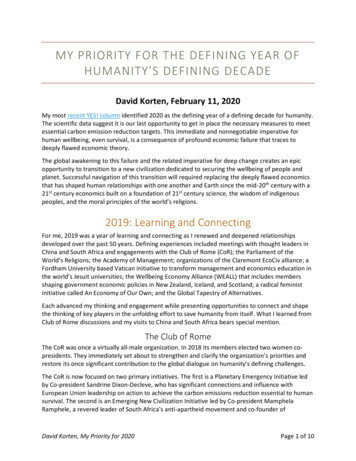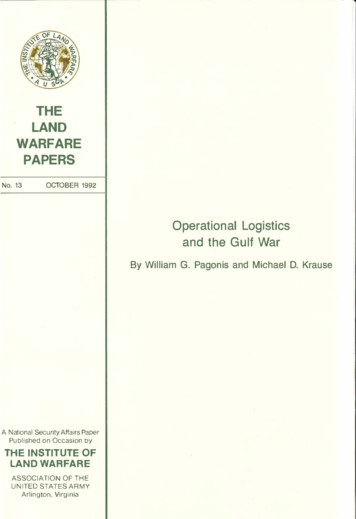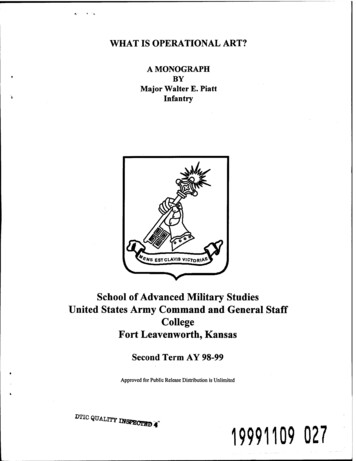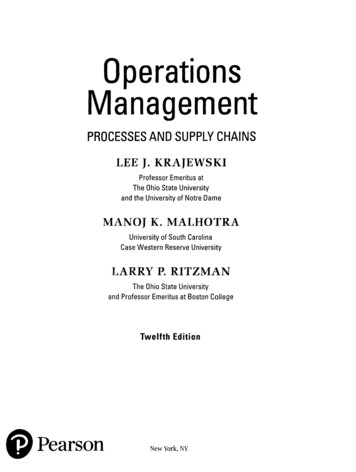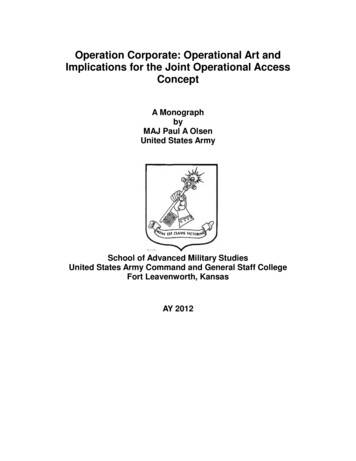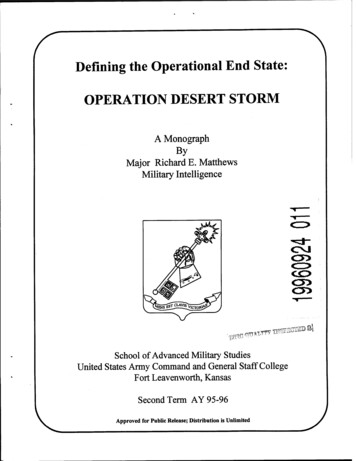
Transcription
Defining the Operational End State:OPERATION DESERT STORMA MonographByMajor Richard E. MatthewsMilitary Intelligence"X/"» CSESSlR"S 'ö4Jwe"'"School of Advanced Military StudiesUnited States Army Command and General Staff CollegeFort Leavenworth, KansasSecond Term AY 95-96Approved for Public Release; Distribution is Unlimited
Form ApprovedREPORT DOCUMENTATION PAGEOMB No. 0704-0188Public reporting burden for the» collection of information is estimated to average 1 hour per response, including the time for reviewing Instructions, searching existing data sources,gathering and maintaining the data needed, and completing and reviewing the collection of information. Send comments regarding this burden estimate or any other aspect of thiscollection of information, including suggestions for reducing this burden, to Washington Headquarters Services. Directorate tor Information Operations and Reports, 1215 JeffersonDavis Highway. Suite 1204. Arlington, VA 22202-4302. and to the Office of Management and Budget. Paperwork Reduction Project (0704-0188). Washington, DC 20S0J.1. A6ENCY USE ONLY (Leave blank)2. REPORT DATE3. REPORT TYPE AND DATES COVEREDMONOGRAPH4. TITLE AND SUBTITLE5. FUNDING NUMBERS6. AUTHOR(S)A/t O »LV lc . AA T-TKH 7. PERFORMING ORGANIZATION NAME(S) AND ADDRESS(ES)8. PERFORMING ORGANIZATIONREPORT NUMBERSchool of Advanced Military StudiesCommand and General Staff CollegeFort Leavenworth, Kansas 660279. SPONSORING/MONITORING AGENCY NAME(S) AND ADDRESS(ES)10. SPONSORING /MONITORINGAGENCY REPORT NUMBERCommand and General Staff CollegeFort Leavenworth, Kansas 6602711. SUPPLEMENTARY NOTES12a. DISTRIBUTION/AVAILABILITY STATEMENT12b. DISTRIBUTION CODEAPPROVED FOR PUBLIC RELEASE:DISTRIBUTION UNLIMITED.13. ABSTRACT (Maximum 200 words)SEE ATTACHED14. SUBJECT TERMS15. NUMBER OF PAGES16. PRICE CODE17. SECURITY CLASSIFICATIONOF REPORTUNCLASSIFIEDNSN 7540-01-280-550018. SECURITY CLASSIFICATIONOF THIS PAGEUNCLASSIFIED19. SECURITY CLASSIFICATIONOF ABSTRACTUNCLASSIFIED20. LIMITATION OF ABSTRACTUNLIMiXEPStandard Form 298 (Rev. 2-89)Prescribed by ANSI Std. Z39-I8
»***ABSTRACTDefining the Operational End State: Operation Desert Storm, By Major RichardE. Matthews, 39 pages. This monograph examines what the author believes should be thecritical first step in operational planning, defining and determining the end state. Theoperational end state is determined by an understanding of the strategic or political aim,and a linking of tactical engagements to achieve that aim. History has shown thatAmerica's armed forces have not always been committed in conflicts with clearly definedend states, and sometimes when it has, commanders on their own have deviated from thepreviously agreed upon end state. Too often there is a desire to become actively involvedin a conflict without any idea for how things will be resolved. Having a clear end state is avision for accomplishing the desired the ends.The Persian Gulf War serves an example of the military success that can beachieved, if political leaders first, define the desired end state, and second, allowed militaryleaders the means and the flexibility to fight the battles to achieve the political goal.Using a combination of theory, doctrine, and history, this paper seeks to establishthat end states must be given more importance in our doctrine and planning. Militaryforces should not be committed unless leaders at every level - strategic, operational, andtactical - have articulated what is to be accomplished. When the end state has beencarefully and clearly stated, American forces have proven they will give the füll measure ofdevotion to that cause.
SCHOOL OF ADVANCED MILITARY STUDIESMONOGRAPH APPROVALMajor Richard E. MatthewsTitle of Monograph: Defining the Operational End State: Operation DESERT STORMApproved by:Monograph DirectorLTC Michael Combest, MMASt/K lsl / rz ICOl/Danny M. Difvft, MA, MMASWL Phillip J. Brookes, Ph.D.ProgramsAccepted this 23rd day of May 1996Director, School ofAdvanced MilitaryStudiesDirector, GraduateDegree
ABSTRACTDefining the Operational End State: Operation Desert Storm, By Major RichardE. Matthews, 39 pages. This monograph examines what the author believes should be thecritical first step in operational planning, defining and determining the end state. Theoperational end state is determined by an understanding of the strategic or political aim,and a linking of tactical engagements to achieve that aim. History has shown thatAmerica's armed forces have not always been committed in conflicts with clearly definedend states, and sometimes when it has, commanders on their own have deviated from thepreviously agreed upon end state. Too often there is a desire to become actively involvedin a conflict without any idea for how things will be resolved. Having a clear end state is avision for accomplishing the desired the ends.The Persian Gulf War serves an example of the military success that can beachieved, if political leaders first, define the desired end state, and second, allowed militaryleaders the means and the flexibility to fight the battles to achieve the political goal.Using a combination of theory, doctrine, and history, this paper seeks to establishthat end states must be given more importance in our doctrine and planning. Militaryforces should not be committed unless leaders at every level strategic, operational, andtactical - have articulated what is to be accomplished. When the end state has beencarefully and clearly stated, American forces have proven they will give the full measure ofdevotion to that cause.
Where there is no vision the people perish.ProverbsIn the beginning plan for the end. Although that seems like an obvious premise, itis easier said than done. In life and in war, success for a learning organization requires avision by the leader of where he wants the organization to go, and that vision must beunderstood by all of its members. In war that vision is called the strategic aim; it must befound at the three levels of war - strategic, operational, and tactical, and it must beunderstood by those fighting the operational and tactical battles. Unfortunately, becominginvolved in conflict without a vision for the end happens; confirming that it is easier to getinto a conflict than extricating oneself once involved. FM 100-5 Operations statessuccinctly, "When the nation commits its armed forces, it should clearly understand whatmilitary end state it wants to achieve."Although it may seem apparent, many commanders fail to understand the necessityto identify and convey a clear operational end state to their subordinates, or why that endstate must drive all actions. When the end state is defined early and properly, it providesfor unity of effort. Without a clear vision of the operational end state, planning andexecution are wasted and ineffective. At the heart of the commander's vision of the endstate is the most important principle of war: the objective.One of the problems of American military involvement in war is the cessation ofhostilities under favorable conditions. Too often, there is a desire to commit forces toconflict without a clear understanding of what we want the situation to be after the
conflict has ended. We need not look back too far to see examples of our failure to definethe military end state. Korea and Vietnam serve as reminders of what can happen whenAmerican policy fails to identify an end state, or focus all efforts toward the strategic aim.Fred Ikle, in Every War Must End, confirms recent historical failure when he states "Manywars in this century have been started with only the most nebulous expectations regardingthe outcome, on the strength of plans that paid little, if any attention to the ending. Manybegan inadvertently without any plans at all."2 It is imperative that a vision of end state becarefully and clearly articulated before committing military forces to a theater of war.Determining the end state is a critical first step in operational planning. Karl vonClausewitz notes that, "No one starts a war, — or rather, no one in his senses ought to doso — without first being clear in his mind what he intends to achieve by that war and howhe intends to conduct it."3 Of course Clausewitz was referring to national leadership, butoperational commanders at their level of war, also have a responsibility to the forces theycommand to not commit them without first being clear in their mind what they seek toachieve as the military end state. When the end state is not provided at the national level,the operational commander by default must establish the end state.Using Operation DESERT STORM as a case study, this paper will examine thePersian Gulf War as another poignant reminder of why the military requires a clearlydefined political end state and why military operations must be linked to the political endstate.Clausewitz, is most often quoted as saying "war is the continuation of policy byother means."4 War in the purest sense results when policy has failed between two
nations. Diplomacy should place a priority to end wars before they start, or as in the caseof the Gulf War, it must create the most favorable conditions possible for war to begin andend. If war is inevitable and if it is to be successful, military operations must be linked tothe strategic aim of policy. The linkage between political ends and tactical means is foundat the operational level in the operational end state. At this level the operationalcommander must translate strategic goals as identified by the National CommandAuthority (NCA) into attainable tactical goals.Several terms require definitions to better understand the construct of this paper.The operational level of war is the vital link between national and theater-strategic aimsand the tactical employment of forces on the battlefield.5 Operational art is theemployment of military forces to attain strategic and/or operational objectives within atheater through the design, organization, integration, and conduct of theater strategies,campaigns, major operations, and battles. Operational art translates the joint forcecommander's strategy into operational design, and ultimately, tactical action, byintegrating the key activities at all levels of war.6 Without operational art, war would be aset of disconnected engagements, with relative attrition the only measure of success orfailure.7 The end state is defined as a set of required conditions which, when achieved,attain the aims set for the campaign or operation.There is no definition for operational end state. For the purpose of this study, theworking definition of operational end state is defined as the required military conditionsbetween the strategic and tactical levels that, when achieved, support the attainment of the
Strategie objectives or pass the main effort to other instruments of national power toachieve the final strategic end state.9The fundamental elements of end state are summed best in the military's capstonemanual, Joint Publication 3.0 Doctrine for Joint Operations:"The desired end state should be clearly described by the NCA before Armed Forcesof the United States are committed to an action. An end state is the set of requiredconditions that achieve the strategic objectives. There may be a preliminary endstate-described by a set of military conditions- when military force is no longer theprincipal means to the strategic aim. . The term 'end state' simply represents the setof conditions necessary to resolve a crisis and transition from predominate use of themilitary instrument of national power to other instruments."A review of military doctrine from the Joint Electronic Library reveals theemphasis the services are now placing on the subject of end state. While joint doctrinedefines and describes end state, the other service manuals only briefly delve into theimportance of this subject. U.S. Navy doctrine is limited on the subject of end state.While the Joint Force Air Command (JFAC) manual mentions end state once, U.S. AirForce doctrine does not deal with the issue of end state in significant detail. FM 100-5 theArmy's capstone manual, stresses the necessity for having a clearly defined end state in thegreatest detail. "When the nation commits its armed forces, it should clearly understandwhat military end state it wants to achieve. . . That end state describes what the NCAwants the situation to be when operations conclude. . "n The U.S. Marine Corps FMFM1-1 Campaigning, is also limited in its approach to the subject with this exception, "Giventhe strategic aim as our destination, our next step is to determine the desired end state, themilitary conditions we must realize in order to reach that destination, those necessaryconditions we expect by their existence will provide us our established aim."12The
study of end state demands more than just isolated paragraphs, it should have its ownchapter, and it ought to be the first chapter of every military manual. Every militaryoperation, no matter the mission must be driven by the desired end state - the outcome.Understanding the end state begins the plan to achieve the political goal.THEORYSun Tzu, Clausewitz, and Henri Jomini each understood the relationship betweenstrategy and tactics, and it is from their works that the theoretical framework foroperational end state will be established. They agree that the decision to initiate war ispolitical and must be made by political leaders. End state development then should be theresponsibility of both politicians and operational commanders. In two places Sun Tzudiscusses the role of politics, "It is said that enlightened rulers deliberate upon plans, andgood generals execute them. . and normally when the army is employed, a general firstreceives his commands from the sovereign. ."Clausewitz is extensive in his approach to politics and war. He offers a ringingtestimony of the connection between war and politics, "War is only a branch of politicalactivity; that is in no sense autonomous . . . war cannot be divorced from political life; andwhenever this occurs in our thinking about war, the many links that connect the twoelements are destroyed and we are left with something pointless and devoid of sense."14Throughout On War, there is a consistent theme, that the purpose of the military is toserve some desired political end state. In Book One, Chapter One he devotes much timeand attention to the subject:"When whole communities go to war whole peoples, and especially civilized
peoples — the reason lies in some political situation, and the occasion is alwaysdue to some political object. War, therefore, is an act of policy . . . Policy willpermeate all military operations, and, in so far as their violent nature will admit,it will have a continuos influence on them . . . War is not merely an act of policybut a true political instrument, a continuation of political intercourse, carried onwith other means. The political object is the goal, war is the means of reaching it,and means can never be considered in isolation from its purpose."15It is from Clausewitz that current U.S. military doctrine on the subject ofoperational end state is derived. "The strategist must therefore define an aim for the entireoperational side of the war that will be in accordance with its purpose . he will draft theplan of war, and the aim will determine the series of actions intended to achieve it. . ,16The strategic aim represents the purpose for which military forces were committed, andClausewitz intended the "series of actions" to be so linked together that it would lead tothe operational end state. While he does not call this the operational end state, by analysisand synthesis, that is precisely what it is.The tack taken by Jomini in his discussion of politics and its association with themilitary is more limited than that of Sun Tzu and Clausewitz. In the chapter titled"Military Policy" in his book The Art of War, he briefly describes two ideas, "prescribedaim and the system of operations," that are akin to establishing an operational end state."When a war is decided upon, it becomes necessary to prepare . a system of operationsin reference to a prescribed aim; to provide a base, as well as all the material meansnecessary to guarantee the success of the enterprise. . the system of operations ought tobe determined by the object of war. "17 In short, Jomini is saying the system ofoperations links the operational end state "the prescribed aim" - and strategic aim -
"the object of war" to tactical operations. Without operational art the strategic level ofwar could not be properly coordinated with the tactical level of war.As previously discussed, the theorists, Sun Tzu, Clausewitz, and Jomini each seethe necessity of using an "aim" to link strategy to tactics. This linkage is critical forobtaining the operational end state, since without it, tactics might not have the focus onthe strategic aim that is guided by the desired policy that it is seeking to achieve.A brief review of the Korean War, Vietnam, and finally the Persian Gulf War willshow the impact of theory on history, and the impact of clearly defining and linkingoperational end states to strategic goals.KOREAPresident Harry Truman made a strategic decision to commit forces to Korea inJune 1950 in an attempt to restore the Republic of Korea, following the surprise invasionby the North Korean Peoples Army. At the next level down — the operational level General of the Army Douglas MacArthur, Commanding General of the Far EastCommand, in deciding which forces would be sent to Korea and what plan would be usedto thwart the communist advance into South Korea was operating at the operational levelof war. As the operational commander, it was MacArthur's responsibility to link militaryoperations in the theater to the national goals of an independent South Korea.Thecommand and control structure in the Pacific and Far East was not designed in expectationof a major war in Asia. U.S. military strategy in the region was not focused on checkingthe expansion of communism in the Far East and Southeast Asia. At the macro level,
failure in Korea can be attributed to U.S. policy in the Far East, the absence of unity ofcommand, the lack of coordination among intelligence gathering agencies, and the failureto remain focused on the stated strategic aim.U.S. national policy was focused on containing the spread of Soviet communismaround the world, but specifically in Europe; Korea had been excluded from the Americandefensive perimeter. In September 1947, President Harry Truman ordered an estimate ofthe importance of further military occupation in Korea from the point of military securityto the United States.18 Secretary of Defense James V. Forrestal responded that the troopsand bases in Korea were of minor strategic value for American security. The Joint Chiefsof Staff reasoned that in the event of war American soldiers would be a liability since theycould not be maintained without substantial reinforcements prior to an attack; anyAmerican offensive launched in Asia would bypass Korea, and air power could neutralizeany threat. Air power was believed to be more feasible and less costly than ground forces.From the strategic viewpoint. . . Korea is of little strategic value to the United Statesand that any commitment to United States use of military force in Korea would be illadvised and impracticable in view of the potentialities of the over-all world situationand of our heavy international obligations as compared with our current militarystrength.19In 1948 no threat appeared imminent and the Joint Chiefs recommended the evacuation ofthe 45,000 troops stationed in Korea, since they could be used more profitably elsewhere.Prior to Korea gaining independence in 1948, the Korean Peninsula fell under theresponsibility of Far East Command. Because Korea fell outside the purview of GeneralMac Arthur's General Headquarters (GHQ), his focus was not on that peninsula, but ondefending east of Korea. As the Commander in Chief Far East (CINCFE) and the
Supreme Commander Allied Powers (SCAP), General MacArthur's primary responsibilitywas in the defense and occupation of Japan, not Korea.His specific missions were defense of the Ryukus and Japan, protection of air andsea lanes in the FEC, denial of Formosa to the enemy, support of the Pacific Command,the Alaskan Command, and the Strategic Air Command, assistance to the Republic of thePhilippines in the defense of the islands, and providing safety for the U.S. personnel inKorea.21 His area of responsibility ran through the chain of islands fringing the coast ofAsia. It started at the Philippines and continued through the Ryukyu archipelago whichincluded its broad main bastion, Okinawa. Then it bent back through Japan and theAleutian Island chain back to Alaska.2Although Korea was outside of the national strategy, an assessment by MacArthurfrom his strategic location, might have refocused part of the defense of Japan by assigningconingency forces to Korea. The Japanese had always been concerned about Korea,having seen it as a dagger threatening Japan. Historically, Korea had been a staging areafor countries attacking the islands of Japan.In response to the North Korean invasion, the Truman Administration allowedunrestricted use of U.S. ground forces in Korea beginning on 1 July 1950. In the previousfive days, only air and naval forces had been introduced in Korea. MacArthur's commandestimate on 29 June left him with the conclusion that only ground forces could save theRepublic of Korea. Three months later, MacArthur's Inchon landing facilitated the Pusanbreakout, and achieved the operational end state repelling North Korea back across the38th Parallel. In war, as elsewhere, nothing succeeds like success. As a result of Inchon,
MacArthur's stock had climbed at the White House. Truman was more disposed to giveMacArthur's military views greater weight. MacArthur was insistent that North Korea beinvaded and was personally convinced that neither Russia nor China would intervene inKorea.23While U.S. operational objectives had been met, Republic of Korea President, Dr.Syngman Rhee, had an agenda of his own, and he aspired for unification of Korea underhis rule. While U.S. planners contemplated the destruction of the NKPA, Dr. Rhee wasformulating plans for South Korean political aims. He had publicly stated his desire tounify Korea under his terms. U.S. ground forces fighting under MacArthur's commandgave him the tool to achieve his aims. Washington had to confront this reality: SyngmanRhee had not the slightest intention of stopping his ROK Army at the 38th Parallel. Hewas hell-bent to unify Korea by force.24U.S. operational goals were not linked to Dr. Rhee's political aims, and hispolitical aims were not linked to U.S. strategic aims. Had the Truman administration andthe United Nations elected to halt the war with the Republic of Korea restored, it mighthave sued for peace under favorable conditions. Instead, National Security Directive(NSD) 81/1, authorized U.N. forces to advance above the 38th parallel. A Joint Chiefs ofStaff (JCS) directive dated 27 September 1950, also authorized U.S. ground forces toadvance across the 38th parallel.The directive was contingent upon: nonintervention of major Soviet or ChineseCommunist forces into North Korea; no announcement of intervention; and no Soviet orChinese military threats to counter MacArthur's operations in North Korea. The only10
restriction in the JCS directive was a caution that non-ROK forces were not to be used inthe provinces of North Korea bordering Manchuria. It set no limit of advance short of theYalu River. MacArthur interpreted the restriction as an east-west line 45-50 miles southof the Korean-Chinese border. He did not seek specific guidance from the JCS, nor didthe JCS question his interpretation.On 24 October 1950, MacArthur removed all restrictions upon non-ROK forcesclearing the way for a push to the Yalu River. In this instance the operational commanderhad taken it upon himself to change the end state without direction, guidance, or approvalfrom the JCS.Clausewitz declares, "The first, the supreme, the most far-reaching act of judgmentthat the statesman and commander have to make is to establish . the kind of waron which they are embarking; neither mistaking it for, nor trying to turn it into,something that is alien to its nature. This is the first of all strategic questions andthe most comprehensive."The next day, 25 October, Communist Chinese Forces (CCF) attacked U.N. forcesto halt the northward advance. This was the fight that the Truman Administration hadfeared in the beginning. U.N. forces were not in North Korea to fight the Chinese, it wasthere to restore independence to South Korea, and to hopefully do it without resorting tonuclear war. The intervention of Chinese forces into the Korean War resulted from a clearmisunderstanding between the use of armed force and a strategic aim.To counter the CCF attack, MacArthur now went back to the JCS and requestedpermission to bomb bridges over the Yalu River. At first the JCS denied permission. Itseemed that China was only protecting its interests and an other than military solutionmight be found; but neither the JCS nor the Truman Administration pursued this approach.11
The next day, 8 November, the JCS acquiesced, believing the theater commander knewbest. Hindsight proves that he did not.The operational commander, Mac Arthur, had operated without national consent.In effect, his actions were establishing new policy for the U.N. and the U.S. Whileprudence advocated allowing this general the flexibility to fight battles, MacArthur'sactions were a detriment to U.S. strategic aims.The final U.N. offensive began 24 November 1950. In the next 24 hours the CCFwould launch its own offensive, halt the U.S. advance, and ultimately push U.N. forcesback past the 38th parallel. All of the previously gained territory was now loss, the U.S.was embarrassed and its foreign policy was suspect, and for his efforts, MacArthur wouldbe relieved.Today, we continue to live with the burden of MacArthur's decision to change theoperational end state that had been approved. More than forty years later it is easy to castblame, but that is not the purpose of this paper. After achieving the operational end state,it was changed by the decision of the theater commander. This was done withoutconferring with the NCA. Clausewitz' fundamental theory that war is the continuation ofpolicy, manifests itself through the understanding and execution of an operational endstate that supports the strategic aim. The operational success of the Inchon invasion andthe Pusan breakout was voided by failing to stay focused on the end state.MacArthur was adept at the operational use of force even without operationaldoctrine to guide him. It can be safely argued that he was a genius, but doctrine isdesigned to provide an alternative to the intuitive use of force.12
In the absence of guidance, it is up to the operational commander to determine thebest way to use his force. Working with little to no guidance, or ignoring what he didreceive, MacArthur proceeded to design and implement the operational art that led toachievment of the operational end state. While he achieved operational success,MacAthur's action led to strategic failure.VIETNAMAmerica's most glaring failure to establish a clearly defined military strategy andend state is Vietnam. Clausewitz' theoretical warning of the need to define an aim for theoperational pursuit of war went unheeded by U.S. planners. Ikle states, "America'sconduct of the war in Vietnam suffered not so much from limits imposed on the use ofmilitary force as from lack of overarching strategy for applying military force in a way thatwould bring the war to a satisfactory end."Before the U.S. became actively involved in Vietnam, it had already observed thefailure of French political and military strategy. Unfortunately, in establishing its policy,the U.S. failed to learn from the French debacle. As early as 1950, France had requestedU.S. assistance to defeat the communist backed Viet Minh. The official policy of theEisenhower Administration was one of non-compliance with any requests for aid. GeneralMatthew Ridgway, Army Chief of Staff, supported that policy and said, "Indochina isdevoid of decisive military objectives and any U.S. involvement there would be a seriousdiversion of limited U.S. capabilities."27 This was one of the few times in the Vietnamcampaign that political and military leaders were in agreement. However, political leaders13
abandoned this policy in favor of direct action. What kind of army, and what kind ofmilitary would America have if it had not resorted to direct action in Vietnam?The United States did not get involved in Vietnam blindly. At the request of theFrench government, it began providing assistance in 1950 and then later to the SouthVietnamese government, with the goal of blocking Communist Vietnamese insurgent'sefforts to topple the Saigon government.28 The French defeat in 1954 left the U.S. indirect confrontation with the Vietnamese communists. The communists attack on SouthKorea, and the growing Soviet menace in Europe made U.S. officials believe that it mustcontain the spread of communism at all costs. Vietnam was another part of the strategy ofcontainment.From 1954 until 1963 the U.S. supported the regime of Ngo Dinh Diem. Thissupport began with a few advisors and monetary aid to the sum of 100 million dollars.By 1963 there were 15,000 advisors in country, and the U.S. was providing 500 milliondollars in aid. This support initially brought success to Diem's regime, and by 1956 90percent of Viet Cong cells in the critical Mekong Delta had been destroyed.29 Despite thissuccess Diem was not able to
campaigns, major operations, and battles. Operational art translates the joint force commander's strategy into operational design, and ultimately, tactical action, by integrating the key activities at all levels of war.6 Without operational art, war would be a set of disconnected engagement
